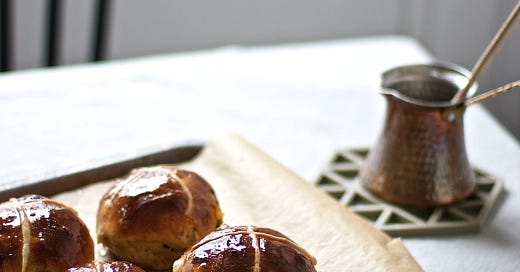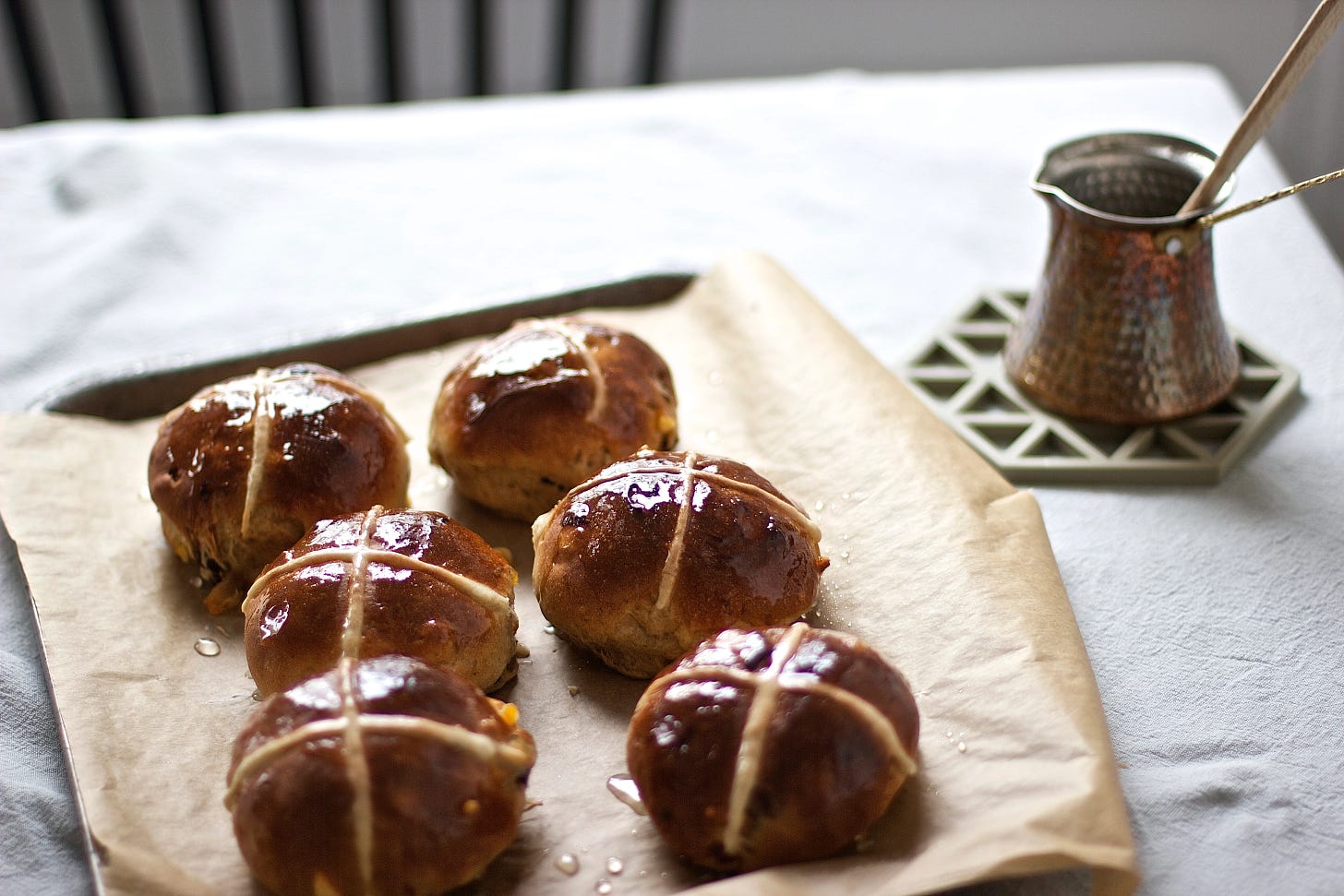Hot Cross Buns with Chinese Five Spice Powder, Prunes and Candied Orange Peel ...
... and some tips and tricks for creating extra pillowy and soft hot cross buns that will stay fresh for days!
Breadbaking is one of those almost hypnotic businesses, like a dance from some ancient ceremony. It leaves you filled with one of the world’s sweetest smells… There is no chiropractic treatment, no Yoga exercise, no hour of meditation in a music-throbbing chapel that will leave you emptier of bad thoughts than this homely ceremony of making bread.
M. F. K. Fisher, “The Art of Eating”
Hello, and welcome to Newsletter No 22 here on Substack! Thank you for stopping by. If you are already subscribed, thank you for supporting my work, it means the world to me! If not, grab a seat if you are interested in recipes as well as tips and tricks to make the most of our increasingly eclectic pantries and a good dose of my at times random musings about all things food - and make sure you hit that subscribe button if you don’t want to miss any future posts!
If my Substack Inbox and Instagram Feed are anything to go by, then the world probably does not need another Hot Cross Bun recipe. But I do hope you will allow me to add to the noise by sharing my own recipe - for what happen to be my favourite Hot Cross Buns made with Chinese Five Spice Powder, Prunes and Candied Orange Peel and an extra pillowy dough that stays fresh for days thanks to the Tangzhong method.*
For someone who loves to play around in the kitchen as much as I do and someone who is always on the lookout to try out different new flavour combinations and ingredients, the fact that playing around with the basic formula for Hot Cross Buns seems to be practically encouraged given the variety of options you can find in bakeries these days is a very good thing indeed. I have seen Carrot Cake Hot Cross Buns. Hot Cross Buns with chocolate, Toffee Fudge Hot Cross Buns, Apple and Cinnamon Hot Cross Buns. Heck, I have even seen savoury Hot Cross Buns. And yet, as much as I love to experiment, these Hot Cross Buns are so good I stopped playing around with different flavour combinations ever since I developed this recipe a few years back. This recipe has simply become my go to formula for Hot Cross Buns. So hope you give these a try because they are a little different and unbelievably delicious!
If you saw my recipe for Prunes and Chinese Five Spice Powder Sticky Toffee Pudding, you already know how much I adore using the mix of cinnamon, cloves, fennel seeds, Sichuan peppercorn and star anise (which typically make up Chinese Five Spice Powder) in desserts. And while Chinese Five Spice Powder is more typically used in savoury cooking, there really is no reason whatsoever to stop there. While the Sichuan peppercorns provide a bit of tingling heat, the overall flavour profile is not far off from mixed spice or gingerbread spice mixes! And, like many of you no doubt, I am forever trying to make the most of my spice drawer and so at some point it just made sense to try substituting Chinese Five Spice Powder for the more commonly used mixed spice in Hot Cross Buns. And because Chinese Five Spice Powder is also similar to the spices that go into Chinese Plum Sauce, I used prunes rather than raisins or currants for the Hot Cross Buns. And what can I say, I haven’t looked back!
As for the dough, it is a simple enriched sweetened dough but one that is extra soft and pillowy and manages to stay fresh for days (should the buns even last that long!) thanks to the Tangzhong method.
*The Tangzhong Method
What is it and how do I prepare it? The Tangzhong method (also referred to as the Chinese roux method) involves cooking a small amount of the flour in your recipe with some of the liquid from your recipe (so milk or water) until it turns into a thick paste. You then add this paste to the rest of the ingredients when preparing your dough. Typically only a very small amount of flour out of the total amount is used - around 5% in terms of weight - and the ratio of flour to liquid is typically 1:5 in terms of weight.
How can I use it? As you cook the flour and liquid into a thick paste, the flour will start to gelatinize. This has a two-fold impact on your dough: 1. It acts as a tenderizer and 2. It allows your dough to absorb more moisture than would otherwise be the case (which is why things prepared with the Tangzhong method will stay fresh for longer - more moisture in the dough means the finished baked good will take longer to dry out!). The Tangzhong method is best used for enriched doughs - e.g. for Japanese-style milk breads, burger buns or indeed sweet enriched bun doughs like the one for these Hot Cross Buns.
If you want to read more about the Tanzhong method, here is an FAQ.
Have you tried the Tanzhong method? If so, what is your favourite thing to bake with it? Let me know in the comments!
Hot Cross Buns with Chinese Five Spice Powder, Prunes and Candied Orange Peel
Notes: What can I say? Make these Hot Cross Buns. By all means skip the Tangzhong if it seems like extra hassle (but trust me it is worth it!), but do try the Chinese Five Spice Powder – it really is delicious (and before you know it you might even start adding Chinese Five Spice Powder to your morning oats!). Or maybe try another spice mix that is lurking in your kitchen drawers. Ras el hanout with chopped dates maybe? Or Persian Advieh with barberries?
Yields 6 hot cross buns
Ingredients
For the dough
235g plus 1 tbsp flour
75ml plus 65ml milk
25g butter
1 egg
3.5g dried active yeast (a generous teaspoon)
2 tsp Chinese Five Spice Powder
1/2 tsp salt
25g brown sugar
50g prunes, chopped finely
50g candied orange peel, chopped finely
For piping the crosses
50g flour
50g water
For the bun wash
50g sugar
25g water
Directions
Start by making the flour and milk paste. In a medium sauce pan on medium heat, whisk together the 1 tbsp of flour and 65ml of milk until the mixture turns into a thick paste. Stir in the butter until it is melted completely, followed by the remaining milk and the egg.
In the bowl of a standmixer whisk together the remaining flour, with the yeast, Chinese Five Spice Powder, salt and brown sugar. Form a well in the centre and pour in the wet ingredients. Knead on low to combine then knead on medium for around 10 minutes or until the dough reaches the windowpane stage (i.e. the dough is very smooth, no longer sticky and can easily be stretched until translucent). Alternatively, knead the dough on your lightly floured countertop until it reaches the windowpane stage. (It is possible to knead this dough by hand and I have done it before I had a standmixer. But be warned - the dough is very sticky to begin with so this may well take 15-20 minutes or more. And in the beginning it will seem like you are merely spreading a sticky floury mess all over your kitchen counter but do resist the urge to add more flour. With some perseverance, plenty of elbow grease (and maybe some entertainment from Netflix) the dough will eventually become smooth, shiny and beautifully stretchy.)
Cover the dough and let rest for 5 minutes (this helps relax the gluten,) then knead in the chopped prunes and candied orange until well distributed. Place the dough back in the mixing bowl, cover and set aside to proof until doubled (depending on how warm your kitchen is this will take around 1 hour).
Pre-heat the oven to 200 degrees Celsius and line a sheet pan with parchment paper.
On a lightly floured surface, divide the dough into six pieces (if you want to be precise, each bun should weigh around 95 grams) and shape into buns. Place the buns, seam-side down on the prepared sheet pan, cover with a kitchen towel and set aside to proof until doubled once more (this should take around 45 minutes).
Whisk the flour together with the water, fill into a piping bag and pipe a thin cross across each bun. Bake the buns for 15-20 minutes (18 minutes seemed to be bang on when I was testing these) or until they are well risen and sound hollow when tapped underneath.
While the buns are in the oven, make your bun wash. In a small sauce pan bring the sugar and water to a boil and cook just long enough for the sugar to dissolve completely.
When the buns are out of the oven, brush generously with the bun wash (store any leftover bun wash in the fridge and use it to sweeten iced coffees, fruit salads and such).









I've never made hot cross buns before, so I appreciate you taking the time to explain which methods work best!
I love the idea of the Chinese five spice partly because I almost never see it used in anything other than meat and I’ve always got a rogue bottle of the stuff languishing in my cupboard that’s so old, it’s probably got rings in it like an oak tree. Cheers for the inspo!